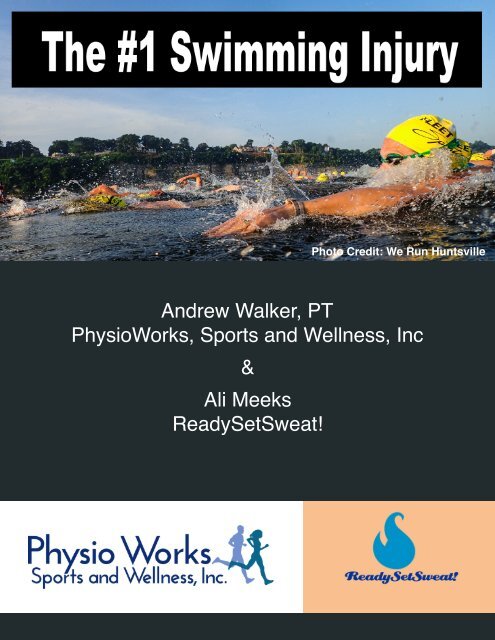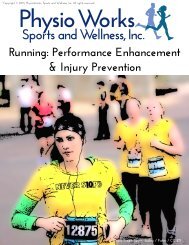The #1 Swimming Injury
Swimmers suffer shoulder injuries more than other injuries. Andrew Walker, PT and Ali Meeks review anatomy, biomechanics, prevention, treatment, and technique. As respective owners of PhysioWorks and ReadySetSweat they collaborate to try and give their clients the best level of care possible.
Swimmers suffer shoulder injuries more than other injuries. Andrew Walker, PT and Ali Meeks review anatomy, biomechanics, prevention, treatment, and technique. As respective owners of PhysioWorks and ReadySetSweat they collaborate to try and give their clients the best level of care possible.
You also want an ePaper? Increase the reach of your titles
YUMPU automatically turns print PDFs into web optimized ePapers that Google loves.
Photo Credit: We Run Huntsville<br />
Andrew Walker, PT<br />
PhysioWorks, Sports and Wellness, Inc<br />
&<br />
Ali Meeks<br />
ReadySetSweat!
Andrew Walker, PT<br />
www.physioworkshsv.com<br />
• Owner PhysioWorks, Sports and<br />
Wellness, Inc.<br />
• Experience Sports Physical <strong>The</strong>rapist<br />
• Worked with professional, collegiate,<br />
high-school athletes in the US and UK<br />
• Member of the APTA Sports Section
Bios:<br />
Ali Meeks<br />
www.readysetsweat.net<br />
• Owner ReadySetSweat!<br />
• Former Div I swimmer<br />
• USAT Level 1 Coach<br />
• American College of Sports<br />
Medicine Certified Personal<br />
Trainer
Photo credit: akunamatata / Foter / CC<br />
Contents:<br />
1. Anatomy and biomechanics<br />
2. Risk factors for injury<br />
3. How can it be avoided, assessed, and<br />
treated?<br />
4. Basics of technique
1<br />
<strong>The</strong> Shoulder is the # 1<br />
injured body part in<br />
swimmers<br />
Let us consider what makes the shoulder so<br />
susceptible to injury. To help we will<br />
compare the shoulder with the hip joint.<br />
What do shoulders and<br />
hips have in common?<br />
• <strong>The</strong>y both need to be stable and<br />
strong<br />
• <strong>The</strong>y are both ball and socket joints<br />
Photo credit: Internet Archive Book Images / Foter / No known copyright
What makes the shoulder<br />
different?<br />
• It needs to be mobile!<br />
• Even in extremes (such as the<br />
splits) the hip only has 1/2 the<br />
motion!<br />
Quick comparison of these<br />
two ball and socket joints:<br />
Ball<br />
2012 study of white americans showed federal<br />
head and humeral head ~same size
Socket<br />
Deep<br />
Shallow<br />
If we rotate our shoulder<br />
90 degrees we see the<br />
relationship of the socket<br />
to the ball. We have a<br />
small/shallow socket with<br />
a relatively large ball. This<br />
creates mobility.
<strong>The</strong> mobility seen in the last picture is only<br />
2/3 of the story. <strong>The</strong> shoulder is not just a<br />
ball and socket joint, it is a complex<br />
including two other joints and a pseudo joint<br />
Acromio-clavicular Joint<br />
Scapulothoracic Joint<br />
(pseudo joint!)<br />
Gleno-humeral<br />
Sterno-clavicular Joint
To get our full elevation at the shoulder<br />
movement occurs between the<br />
glenohumeral joint and the scapula with a<br />
2:1 ratio<br />
Evidently we have a lot of mobility in the<br />
shoulder! What gives the shoulder<br />
stability?
Several things keep the shoulder stable:<br />
• Labrum<br />
• Joint capsule<br />
• Ligaments<br />
• Muscles<br />
Mostly we cannot change the structure<br />
of the ligaments, labrum, capsule (unless<br />
they are broken and need to be<br />
surgically fixed!)<br />
However we can change the properties<br />
of muscles, so let us look at this aspect<br />
of the anatomy in more detail!
We have muscles that are very intimate with<br />
the glenohumeral joint and control position:<br />
<strong>The</strong> Rotator Cuff<br />
<strong>The</strong> two rotator cuff muscles not seen in this<br />
picture are the Infraspinatus and the Teres<br />
Minor.<br />
<strong>The</strong>re are also superficial muscles, such as<br />
the deltoid, which provide more powerful<br />
movement.
We have muscles both deep and<br />
superficial that control the movements of<br />
the scapula<br />
<strong>The</strong> muscles of the rotator cuff and the<br />
scapula have to work well together for<br />
the shoulder to function properly
2<br />
<br />
Three risks of injury:<br />
• Structural differences<br />
• Lack of strength/control<br />
• Overload<br />
Photo credit: irrezolut / Foter / CC
Structural differences<br />
• Primary - those that we have from<br />
birth<br />
• Secondary - those that we have<br />
acquired, e.g. poor posture etc<br />
<br />
When looking at the<br />
shoulder from the side<br />
we can see an example<br />
of a primary impingement.<br />
<strong>The</strong> acromion is part of the<br />
shoulder blade. Some acromion<br />
processes are flat whereas some<br />
are hooked. Impingement means a<br />
structure such as the rotator cuff is<br />
pinched between the ball and acromion.<br />
Someone with a hooked acromion has<br />
less space and therefore more chance of<br />
impingement.
Lack of Strength/Control<br />
• To reach for a cabinet all of our<br />
joints need to move in a particular<br />
way.<br />
• This is true not just in the shoulder.<br />
For flexion to occur efficiently at the<br />
shoulder we need all of our joints to<br />
move correctly, e.g. trunk, legs, etc.<br />
• This is not just the case in high level<br />
activity such as swimming, but as<br />
simple a motion such as raising<br />
your arm.<br />
• Recent research showed that to<br />
initiate shoulder flexion the first<br />
muscle that contracts is the soleus<br />
in the calf!
When control is not within the required<br />
parameters for our planned motion we<br />
tend to stress certain parts of a joint.<br />
Below is an example of places that an<br />
impingement can occur in the<br />
glenohumeral joint:
Overload<br />
• <strong>The</strong> different tissues of the body<br />
(bone, muscle, tendon, ligament)<br />
need to have the correct properties<br />
for the load that will be placed on<br />
them<br />
• If load/stress is higher than the<br />
properties of the tissue you<br />
increase the risk of injury,<br />
particularly overuse injury.<br />
<br />
Internal impingement is a good example of overload. It is thought to occur<br />
in sports with repetitive motions where the joint is lax. This leads to<br />
pinching of the underside of the tendon.
Swimmers Shoulder….<br />
We hate this term!!!<br />
• <strong>The</strong>re are so many possible<br />
diagnoses:<br />
1. Rotator Cuff Tendonitis<br />
2. Labral Tears<br />
3. Scapula Dyskinesis<br />
4. Biceps tendonitis<br />
5. …..<br />
• All or any of these injuries are a<br />
result of a combination of our three<br />
risk factors:<br />
1. Structural differences<br />
2. Lack of control<br />
3. Overload
3<br />
How can it be<br />
avoided, assessed<br />
and treated?<br />
<br />
Photo credit: Borsook D, Moulton EA, Schmidt KF, Becerra
To help avoid injury always use good<br />
pain guidelines:<br />
You can read more about pain and<br />
performance in our blog article.
Always use good warm-up and cooldown<br />
routines. <strong>The</strong> videos below give<br />
some suggestions:
• You can use sensible self-treatment<br />
when the pain is in the safe or<br />
caution zones. If pain is<br />
consistently in these zones it may<br />
be wise to consult a professional in<br />
sports medicine<br />
• When the pain creeps into the<br />
danger zone you need to get<br />
attention<br />
• Orthopedic physicians are very<br />
good at diagnostics when there is<br />
an injury. i.e. a tear. Even when<br />
there is a tear there is growing<br />
research indicating PT is worth<br />
trying before surgery (But obviously each case/injury is<br />
different, discuss with your healthcare provider!)<br />
• All this being said, it is worth<br />
considering a biomechanical<br />
screen in the absence of pain to<br />
help reduce your risk of injury!<br />
Physical <strong>The</strong>rapists are great<br />
people to see for this!
4<br />
Technique basics<br />
- safe form<br />
Photo Credit: We Run Huntsville
Don’t enter thumb first!
Do enter middle finger first
Don’t downpress or “dig for<br />
clams”
Do bend the elbow after entry
Don’t use a wise s-pull pattern
Do keep the hand basically<br />
under the body after starting<br />
pull
Don’t cross over the center line
….and underwater<br />
Do stay on the correct side<br />
over water….
Conclusion<br />
• <strong>The</strong> shoulder is a complex structure<br />
in the sense that it has several<br />
components.<br />
• But it is not complex for an<br />
experienced sports medicine<br />
professional.<br />
• Experienced sports medicine<br />
professionals, especially those who<br />
work in collaboration can help you<br />
avoid injury and treat it in the best<br />
way when it does occur.<br />
For your Physical <strong>The</strong>rapy needs:<br />
Andrew Walker PT<br />
www.PhysioWorksHSV.com<br />
For your swimming, and triathlon needs:<br />
Ali Meeks<br />
www.readysetsweat.net
Other useful resources:<br />
moveforwardpt.com<br />
swimspeedsecrets.com<br />
swimsmooth.com<br />
usaswimming.org



